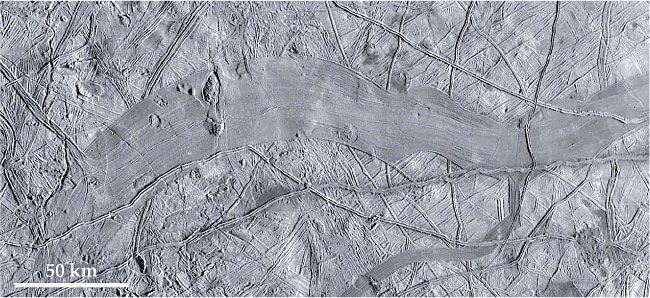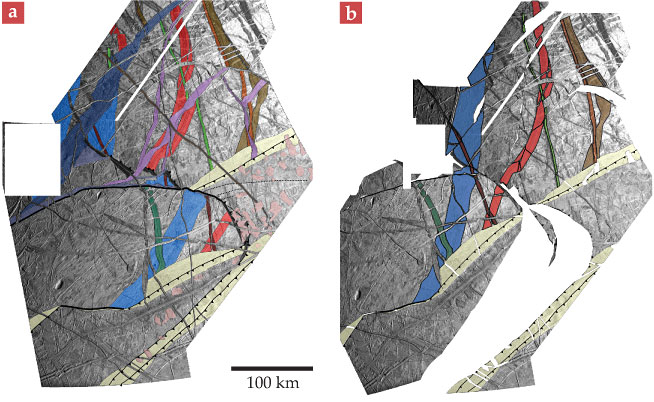Europa may host a system of tectonic plates
DOI: 10.1063/PT.3.2570
In the 11 years since the Galileo spacecraft transmitted its last pictures of Jupiter and its satellites, those who study the icy Jovian moon Europa have been left with a puzzle. Pieces of the Europan crust appear to have cracked and drifted apart over time, with new regions of pristine water-ice crust forming in the gaps. Those so-called dilational bands make up tens of percent of the total surface area. And the paucity of craters on Europa’s nearly unblemished face suggests that the whole surface has been recycled over the past 40 million to 90 million years, just 1–2% of the moon’s age.
And yet there was no clear sign of any process capable of consuming surface area at the same rate as it’s produced. Europa as a whole is not getting any bigger. So where is the extra surface going?
Simon Kattenhorn (formerly of the University of Idaho) and Louise Prockter (of the Johns Hopkins University’s Applied Physics Laboratory) think they might have the answer. 1 By reanalyzing an old Galileo image of a 134 000-km2 region, slightly less than 0.5% of the total surface, they make the case that Europa’s crust, at least in that region, is made up of tectonic plates similar to those on Earth. To satisfy the definition of a plate-tectonic system, the researchers found that not only do the plates drift apart and slide alongside each other, they also subduct, or move underneath one another. If subduction turns out to occur across its surface, Europa would be the first body other than Earth known to have tectonic plates.
Dilation without contraction
The idea of Europan plate tectonics predates Galileo by more than a decade. In 1979 the two Voyager spacecraft sped by Jupiter and offered the first good look at the Jovian satellites. The Voyager images of Europa, taken from a distance of a few hundred thousand kilometers, showed the moon’s surface to be crisscrossed by dark lines and bands. The following year Paul Schenk, then an undergraduate student working with Carl Seyfert Jr at Buffalo State College, spotted a curious property of the images. When narrow linear features passed across certain dark bands, they didn’t perfectly line up. Features on one side of a band were shifted with respect to those on the other. But when the area of the band was excised and the two sides were fitted together, the features could be made to align.
Schenk wanted to call his discovery plate tectonics. “But there was resistance to the idea,” he recalls, because his analysis showed plates only diverging and moving laterally, never converging. Nine years and four revisions later, his paper was published, 2 with the more cautious subtitle “Evidence for a mobile ice shell.”
Galileo was designed to get a closer look at the Jovian system (see the article by Torrence Johnson, Physics Today, April 2004, page 77

Figure 1. Dilational bands, such as the one running horizontally across this image, appear to have formed on Europa’s surface when rigid icy plates moved apart from each other and new crust was formed in between. Finding the complementary mechanism that consumes surface area has been a long-standing challenge. (Adapted from ref.

But there was still no evidence of plates moving together. And subduction is by no means the only possible process that could consume the excess surface area. For example, a single sheet of ice, squeezed from both sides, could shrink in area by warping, thickening, or otherwise deforming. 4 Parts of the Europan surface do exhibit folds and buckles in the ice, but not enough to accommodate all the new area of the dilational bands.
Tectonic reconstruction
When Galileo ended its mission, new images of Europa stopped coming in. In the years since then, researchers have been poring over the same images again and again, looking for anything they might have overlooked that would solve the area-balance problem. Says Kattenhorn, “We’re really scraping the bottom of the barrel.”
The image Kattenhorn and Prockter used to make their case for subduction was of medium resolution, about 200 m per pixel, so it hadn’t been quite as closely scrutinized as those that show finer levels of detail. And the researchers had an intuitive sense that something significant was going on: “There was something about the geometry of it,” says Kattenhorn, “that reminded us of subduction zones on Earth.”
Figure 2a shows the image with its relevant geological features highlighted in color. The purple and dark blue areas are relatively young dilational bands; brown, red, green, and medium blue mark older features that have been broken up by more recent activity. The features ultimately identified as subduction bands are shown in light beige.

Figure 2. Turning back time on tectonic plates. (a) In this 134 000-km2 region of Europa, relevant geological features are highlighted in color: young dilational bands in purple and dark blue, newly identified subduction bands in light beige, and older structures in other colors. (b) Undoing the effects of a possible tectonic process yields this reconstruction. The large white gap and the abrupt termination of the older geological features suggest that portions of crust have been lost to subduction. (Adapted from ref.

The researchers divided the region into 16 putative tectonic plates, with boundaries determined by the features’ discontinuities. Then they meticulously translated and rotated the plates to reverse the effects of a possible tectonic process, first undoing the spreading that formed the young dilational bands, then shifting the remaining plates around until all the older features were aligned. Getting all the right steps in the right order was no trivial task. “All told,” says Kattenhorn, “the process involved many months of meticulous mapping and reconstructing.”
The resulting tectonic reconstruction, shown in figure 2b, features a 99-km gap (the extended white area), which Kattenhorn and Prockter see as a sign that the icy plate once filling that area has been pushed underneath another in the subduction zone along the lower right edge of the region. Furthermore, the blue, green, red, and brown features all end abruptly at the subduction zone across the middle of the region; no continuation of any of them can be found anywhere in the plates on the other side. The researchers conclude that parts of those features have also been lost to subduction.
Falling ice?
Whether subduction occurs anywhere else on Europa apart from the small area in figure 2 remains to be seen. If it does occur elsewhere, Europa could provide insight into which aspects of plate tectonics are general and which are specific to Earth. One difference is already clear: Terrestrial tectonic plates are made of rock, and Europan plates are made of ice. On Earth, cold oceanic crust is often denser than the hot silicate mantle, and it becomes denser still as its mineral form changes under pressure. As a result, subducting slabs can sink into the deep mantle, further shifting the attached crustal plates in the process.
But buoyancy prevents Europa’s crust from descending into the liquid-water ocean that lies underneath. It’s not clear what forces would drive the plate motions in that scenario. Kattenhorn and Prockter hypothesize a model in which only the outermost layer of Europa’s ice shell—the coldest, densest, most brittle ice—is divided into plates. Subducting plates then could still be pulled downward through a layer of warmer, slushier, less dense ice. The researchers propose the term “subsumption” to describe the process and differentiate it from terrestrial subduction, but they stress that the theory has yet to be worked out.
Europa’s ocean is thought by many to be one of the most likely homes in the solar system for extraterrestrial life. Of the three ingredients necessary for life as we know it—liquid water, energy, and the right chemical building blocks—Europa has plenty of the first two, thanks to tidal heating by Jupiter, but its chemical environment is largely unknown. The ions and electrons trapped in Jupiter’s magnetosphere bombard Europa’s surface, producing molecular oxygen, ozone, hydrogen peroxide, and other oxidants. 5 But for those molecules to drive the chemical reactions of life, some mechanism needs to transport them from the surface into the ocean. Subduction (or subsumption) could do just that.
Solving Europa’s mysteries will require a new spacecraft to visit the moon and collect more data. The Europa Clipper, a NASA mission concept currently under study, promises a treasure trove of high-resolution images and other measurements—but not for at least 15 years. In the meantime, Kattenhorn and Prockter’s analysis suggests that undiscovered clues may still be hiding in the images from Galileo.
References
1. S. A. Kattenhorn, L. M. Prockter, Nat. Geosci. 7, 762 (2014). https://doi.org/10.1038/ngeo2245
2. P. M. Schenk, W. B. McKinnon, Icarus 79, 75 (1989). https://doi.org/10.1016/0019-1035(89)90109-7
3. L. M. Prockter et al., J. Geophys. Res. Planets 107, 5028 (2002). https://doi.org/10.1029/2000JE001458
4. L. M. Prockter, R. T. Pappalardo, Science 289, 941 (2000). https://doi.org/10.1126/science.289.5481.941
5. R. E. Johnson et al., Astrobiology 3, 823 (2003).https://doi.org/10.1089/153110703322736123
